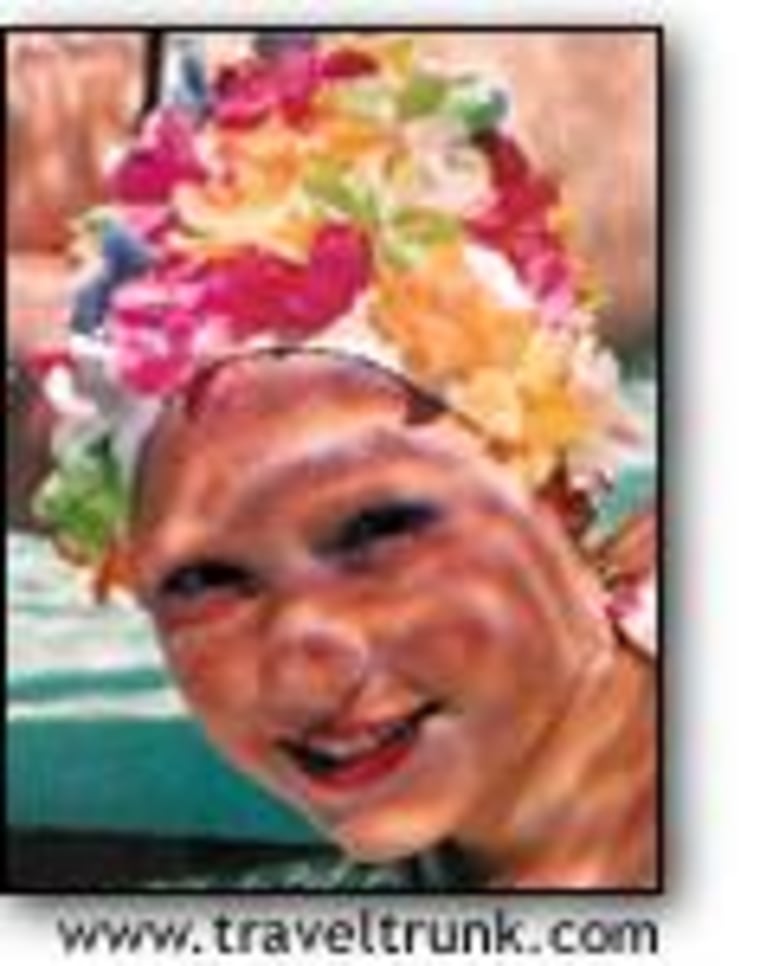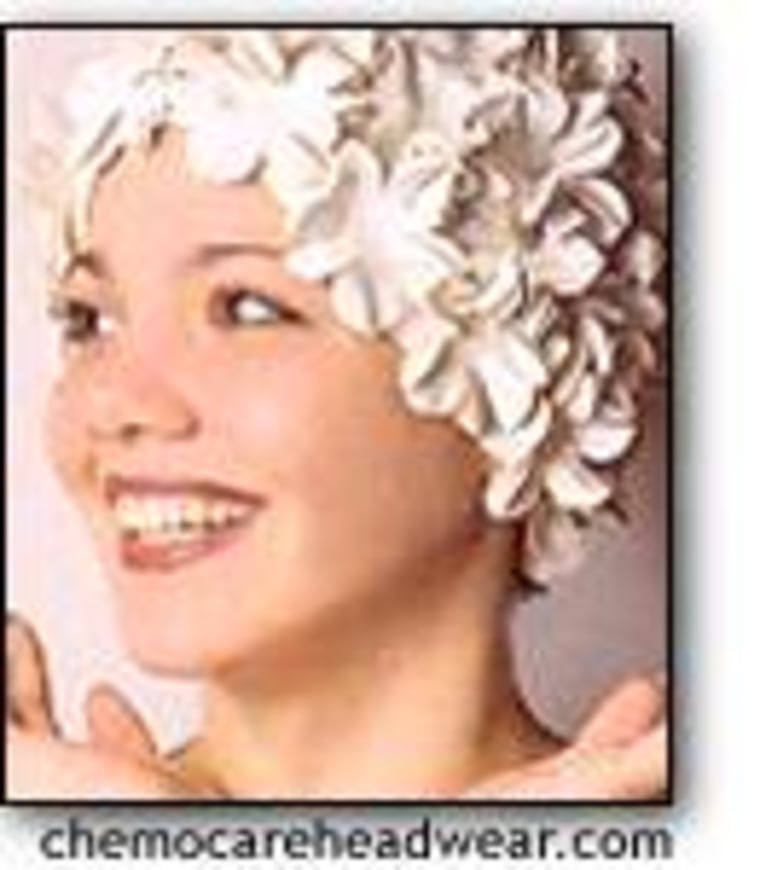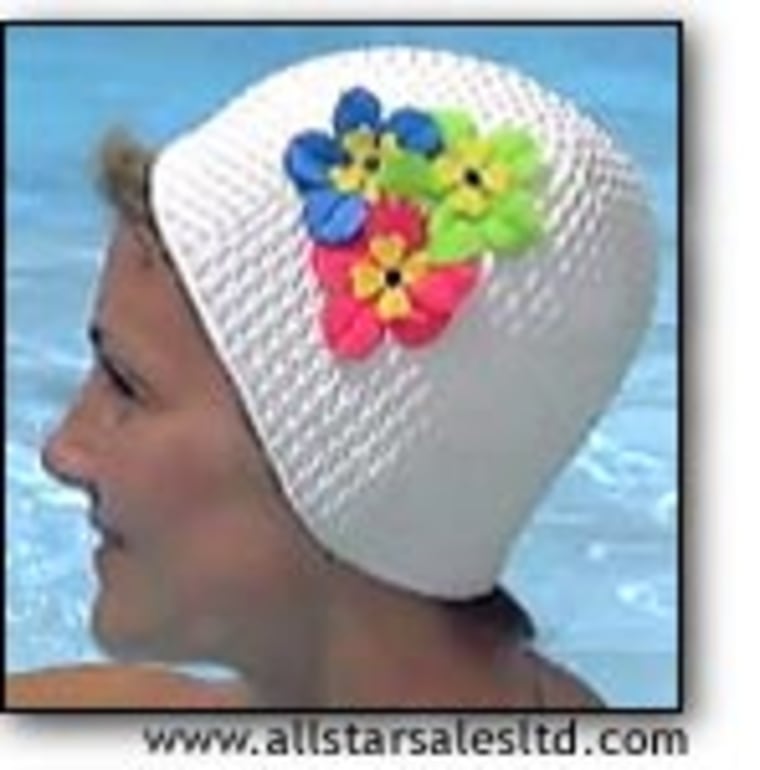A fabulous, flower-covered bathing cap was spotted at one of Manhattan’s indoor pools earlier this summer. Who knew those things were still being worn? As it turns out, retro-style caps are making something of a virtual splash, too — on the Web. Plus, readers write in for details on a new hair-straightening technique.
Dear Personal Shopper: As an avid watcher of the “Today” show, both my wife and I enjoy the articles and features on fashions, trends and such. We’ve noticed that you often feature summer swim wear and swim suits, but there’s also a big trend moving back toward the old-fashioned swim caps and bathing caps of yesteryear. Why don’t you have a few models sporting the traditional caps with flowers and the styles with chin straps — just like they used to wear back in the 1960s and 1970s, especially since there’s a lot of interest in nostalgia these days. — Deborah and David Haste
Dear Deborah and David,
I have no influence at the “Today” show to even suggest that the models sport these dazzling swim caps from the 1960s and 1970s. But your note inspired me to see what I could find in cyberspace. And once I hit the Web, I discovered that you are one of the few e-retailers that sell the vintage-style caps online. Shame on you for not revealing your swim-cap business interests. I can’t really agree that there is any “big trend” toward retro swim caps, but the frilly head coverings are making some waves, in their own right, on the Web. So let’s check them out:
The history of these decorative caps is documented online at “The Swim Cap Guide.” Old snapshots — scanned off Playtex boxes that housed the caps — can be seen on the site’s vintage page. In one, a carload of cap-covered women cruises along the beach in an open-top convertible.
Playtex and Kleinerts made most of the caps back then. Other manufacturers included Pretty Products and US Rubber. Today, Jantzen is one of the few manufacturers that still make the floral caps.

After seeing a few of the chin-strap caps in a small drugstore, David and Deborah Haste (the two letter writers above) decided to sell the vintage-style caps at traveltrunk.com, which generally stocks unusual products from the couple’s travels around the world.
The Hastes, big fans of the J. Peterman catalog, contacted Jantzen and voila! The manufacturer’s vintage cap collection was available online.
The Ft. Lauderdale, Fla.-based cyber shop offers several styles, from the classic chin-strap cap in white for $4.99 to a multicolored flower-covered cap for $13. The plain caps also come in pale pink or blue for $5.99. A waffled-textured cap is available in yellow, teal green, hot pink and blue for $8.99. The flower-covered caps also come in all white or all blue.
Cosmetic uses, too

The puffy, floral caps are not just a fashion statement. They’re perfect for hair-loss patients, says Maggie Wilson, owner of chemocareheadwear.com, which specializes in products for people with hair loss from medical treatment or diseases, such as chemotherapy, radiation and alopecia. “The main reason, they (hair-loss patients) use these swim caps is to give the illusion of depth to the head, eliminating the bullet-head look,” Wilson says. Swim caps also protect the bald sensitive scalp from the sun’s rays reflected off the pool’s waters.
The shop, based in Grosse Pointe Farms, Mich., sells Jantzen’s flower-covered caps in white, pink, sky blue or a multicolored mix for $14.94. “The cap has generic flower petals on it. I cannot say which flower it represents,” says Wilson, who adds, “The petals are secured at the base of each petal with its loose end free to jiggle in the breeze.” The company also stocks a molded swim cap, also made by Jantzen, with cabbage roses molded onto its surface. “It is a more streamlined look,” says Wilson. The cap, which costs $12.95, comes in white, yellow, lavender, hot pink and ocean blue.

Ontario, Canada-based All Star Sales, which started as a pharmaceutical company specializing in ear protection, has its own line of frilly caps made in the Far East. The most striking is the black-and-white striped cap for $15.50. Other caps, priced at $8.50, feature a cluster of petals off to one side, or a colorful border of petals around the cap’s circumference.
My favorite is the simple white cap with three flower petals for $8. I vaguely remember wearing a cap just like that for a water ballet at camp. I was no Esther Williams though.
Washing out those curls
Dear Personal Shopper: On the “Today” show, I heard the end of an interview by Katie Couric on the subject of curly hair. She interviewed a lady who was discussing what one could do for this problem. Do you have any information on this? — Susan T. Ravenel
Dear Personal Shopper: I am a hairdresser in Montana and would like to know more about the thermal (something) treatment for straightening and de-frizzing hair. I saw the story on the “Today” show. Any information you can send would be very appreciated. Thank you. — Kim McIntyre
Dear Personal Shopper: Thermal Hair Conditioning originating in Japan — How can I find out about salons that offer this service? I would like to know about salons in Los Angeles and New York. Thank you. — From a miserable frizzy!
Dear Personal Shopper: As an African-American female viewer, I am once again surprised and upset at how something black people have been doing forever, is “discovered” and represented as new. Processing hair is not new, and from Japan? Do Japanese women need help straightening their hair? We have been processing our hair for so long that we have a whole vernacular regarding this ...”your process has recessed” which means, of course, you need a touch up. There are many more idioms, but I am afraid they might appear as the new language of white women able to afford the outrageous prices being charged to scalp them. I’ve watched “Today” show 24/7, so I would love a reply.— Kathleen Clarke
Dear curly tops, Curly hair is a not a problem. Straightening curly hair can be. Historically, otherwise sensible women have done almost anything to unwrap their natural curls. As a teenager with a thick head of curly/frizzy/unruly hair, I tried several techniques myself. Over-the-counter products such as “Get Straight” and the “Girl from Uncurl” just made my hair sticky and depleted my limited allowance. The most effective and safe technique at the time was sleeping with a ponytail on the top of my head wrapped up in ace bandage. With all these methods, in a few days or less, the hair returned to its naturally curly state.
One very much talked about technique these days is thermal reconditioning, or TR. TR actually changes the internal structure of the hair and treated hair remains straight, says Vincent J., the stylist who appeared on the “Today” show and runs the Vincent J. Salon in Ft. Lauderdale, Fla. The technique, imported from Japan, can take up to six hours and ranges in price from $300 to $1,000. Touchups are needed for new growth and cost about the same.
The Japanese method, also known as Japanese hair straightening and thermal reconstruction, involves applying a series of solutions, rinsing the hair several times and ironing small sections of the hair, one at a time. A special iron with ceramic plates is used. Three companies make TR products in the United States: Yuko Systems, Bio Ionics and Liscio/Milbon. From his experience in the field, Vincent J. favors Yuko Systems or Milbon over Bio Ionics.
Before you commit to any process, check out the consumer reviews on one of these message boards: beautywalk.comheaven-earth.com and virtualrunway.com. At beautywalk.com, CurlyQ in Seattle rightly asks, “Has anyone had TR for a year or longer?” Megan, a one-year TR veteran this month, answers: “My hair has kept a majority of its shine but on humid days it is beginning to frizz again. I find my hair curling every now and then, but the curls are far less drastic from before I had TR. Even now with the some frizz and curls, I highly recommend getting TR done.”
Others complain the treatment didn’t work at all. “I am completely unhappy with the results. My hair is incredibly frizzy,” says Ria, who had TR at a salon in Brooklyn.
If you plan to take the plunge, locating a salon is easy at thermalreconditioning.com. Not surprisingly Beverly Hills, home to Yuko systems, has many salons offering the technique. I found one salon in Los Angeles called straightperm.com. In New York, you’ll notice about 20 salons, located in diverse areas from Bayside, Queens, to Armonk, with the majority in Manhattan. Montana has no listings. The closest salon to the mountainous state is Lotte’s Beauty Salon of New York, in Seattle.
TR is not recommended for African hair because the solutions are not strong enough and the iron is too hot, Vincent J says. “TR does work great on ‘mixed hair,’ as well as Latin or Semitic hair,” he says. Hmm, maybe I’ll revisit the idea.
Teri Goldberg is MSNBC.com’s shopping writer. Write to her at personalshopper@msnbc.com